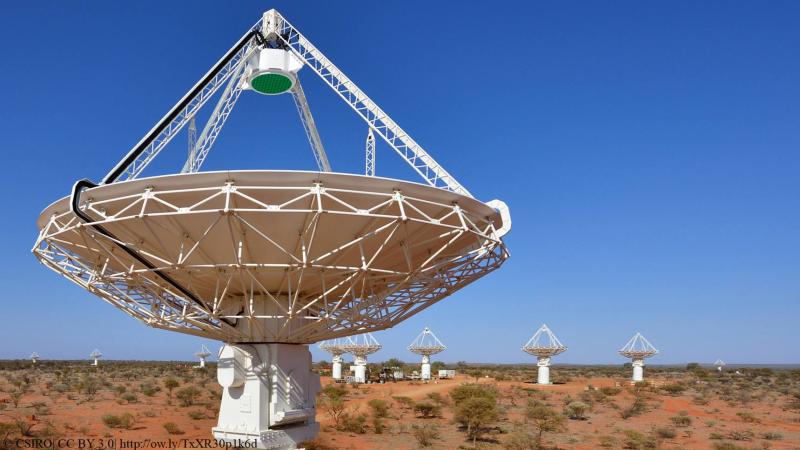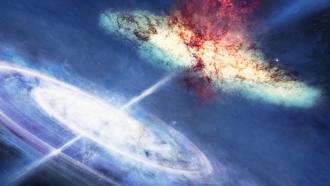
In a breakthrough that can further our understanding of what makes up our Universe, astronomers have detected a bright burst of radio waves, lasting about a millisecond, from the centre of a bright galaxy more than three billion light years away. A team of researchers, led by Prof. Keith Bannister at the Commonwealth Science and Industrial Research Organisation (CSIRO) in Australia, observed this burst using the Australian Square Kilometre Array Pathfinder (ASKAP) telescope.
“ASKAP is a radio telescope situated in Western Australia consisting of 36 antennae of 12-metre diameter. The antennae are arranged in a specific layout spread over six kilometres”explains Prof. Neeraj Gupta of the Inter-University Centre for Astronomy and Astrophysics (IUCAA), Pune.
In an interview with Research Matters, he further explains, “A technique of combining signals from these together known as interferometry enables us to achieve the imaging capability of a 6km diameter telescope”. Prof Gupta is also the researcher responsible for designing the layout of ASKAP dishes, and one of more than fifty researchers who are part of this study.
The ASKAP telescope has a specially designed mode to look for rapid pulses, such as the one detected by the current study. By combining data from several of its antennae, the researchers were able to pinpoint the exact source of this burst of radio waves. They identified this burst as a ‘Fast Radio Burst (FRB)’, because of the bright flash of radio waves.
Ordinary matter, consisting of elements in the periodic table and made up of protons and neutrons, known as baryons, makes up less than 5% of the mass of the Universe. Of this, only about 10% is in stars and cold gas. The rest of the matter is thought to occupy the space between galaxies and is known as the intergalactic medium. Although the exact nature of the fast radio bursts is still unknown, scientists speculate that studying the radio waves emitted by such bursts can illuminate the intergalactic medium, and help us learn about its properties.
"FRBs can throw insights about several critical properties of the intergalactic medium. Fundamentally, we are going to be able to find the entirety of this cosmic web of material", says Dr Ryan Shannon of Swinburne University of Technology, Centre for Astrophysics and Computing in Melbourne, Australia, who is one of the authors of the study.
"Astronomers know it exists, but have not been able to directly measure it because it is nearly invisible to other types of observations, so they say it is missing. With fast radio bursts, we can measure it as we are sensitive to all of it," he explains, in an interview with Research Matters.
The researchers tried to identify the galaxy from which this burst originated by aligning the radio image they obtained with ASKAP, with an optical image of the same region of the sky, and comparing the burst site with locations of known galaxies. They used observations of the same part of the sky by another radio telescope called the Australia Telescope Compact Array (ATCA) that is sensitive to fainter objects. They aligned the positions of three previously-known sources that continuously emit radio waves, in each of the images. Besides, they also aligned their radio image with optical observations made by the Dark Energy Survey, which uses light waves, and the Gaia mission, to obtain precise positions.
The researchers finally zeroed in on a galaxy three billion light years away as the source of these radio waves and determined its properties. Outside of the brief duration of the observed fast radio burst, the host galaxy does not appear to be emitting radio waves.
"The accuracy of the position measurement is very impressive. We have been able to tell not only what galaxy the burst came from, but where within the host galaxy the burst was emitted," remarks Dr Shannon. It turns out that the host galaxy is about the same size as our galaxy— the Milky Way.
ASKAP, the radio telescope used to detect the FRB in this study, is a precursor of the upcoming Square Kilometre Array (SKA) which will be the world's largest and most sensitive radio telescope. India is one of the thirteen member countries of the SKA collaboration.
Dr Shannon is excited about the upcoming SKA project calling it "a phenomenal instrument for detecting FRBs". It will have the sensitivity to detect more bursts and distant bursts, than what we currently can, providing a sneak-peak of the younger Universe. "Finding distant bursts is especially exciting as the Universe was a wild place when it was much younger. By collecting a large sample of bursts, we will be able to see how the amount of intergalactic material varies with burst distance. This understanding will prove that the material exists, and the missing matter will be found," he explains. These observations will also explain how this material is spread out between galaxies.
Until the SKA comes up, the researchers will try to get sharper images of the host galaxy using optical and infrared light to better understand the environment that produced the burst. “This will give us a better understanding of what could produce the extremely powerful blast of radio waves, which is still a mystery,” concludes Dr Shannon.






